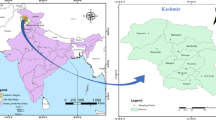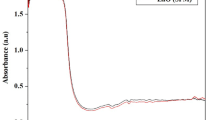Abstract
The recovery of metals from electronic waste was investigated by using fungal strain Aspergillus fumigatus A2DS, isolated from the mining industry wastewater. Fifty-seven percent of copper and 32% of nickel were leached (analyzed by Inductively Coupled Plasma Atomic Emission Spectroscopy (ICP-OES)) by the organism after one-step leaching at a temperature of 30 °C (shaking condition for 7 days). Maximum % of copper and nickel were obtained at a pH of 6 (58.7% Cu and 32% Ni), the temperature of 40 °C (61.8% Cu and 27.07% Ni), a pulp density of 0.5% (62% Cu and 42.37% Ni), and inoculums of 1% (58% Cu and 32.29% Ni). The XRD pattern of PCB showed 77.6% of copper containing compounds. XRD analysis of the leachate residue showed only 23.2% Euchorite (ASCu2H7O8) and 9.4% other copper containing compounds, indicating the leaching property of the fungus. HPLC analysis of the spent medium showed the presence of different acids like citric, succinic, and fumaric acid. The FTIR spectrum showed a decrease in carboxylic stretching in the leachate produced after bioleaching using spent medium. ICPOES of the leachate obtained using spent medium showed that 61% of the copper and 35% of nickel were leached out after seven days of incubation at shaking condition and 57% of copper and 32.8% of nickel at static condition confirming acidolysis property of the strain. A. fumigatus A2DS metal absorption and adsorption ability were observed using transmission electron microscopy (TEM) and scanning electron microscopy energy dispersive X-ray (SEM-EDX) respectively. The results thus indicate that bioleaching of Cu and Ni is bioleached by A. fumigatus A2DS.







Similar content being viewed by others
References
Amiri F, MousaviSM , Yaghmae iS, Bara M 2012 Bioleaching kinetics of a spent refinery catalyst using Aspergillus niger at optimal conditions Bioch Biochem Eng J 67 208 217
Asghari I,Mousavi SM, Amiri F Tavassoli S 2013 Bioleaching of spent refinery catalysts: a review J Ind Eng Chem 19 069 1081
Bhumika R, Khatri Asha B, Sodha Monal B, Shah Devayani R Tipre, Shailesh R, Dave 2018 Chemical and microbial leaching of base metals from obsolete cell-phone printed circuit boards. Sustain Environ Res 333–339.
Bosshard P, Bachofen R, Brandl H 1996 Metal leaching of fly ash from municipal waste incineration by Aspergillus niger Environ Sci Technol 30 3066 3070
Brandl H, Bosshard R, Wegmann M 2001 Computer-munching microbes: metal leaching from electronic scrap by bacteria and fungi Hydrometallurgy 59 319 326
Bullen HA, Oehrle SA, Bennett AF, Taylor NM, Barton HA 2008 Use of attenuated total reflectance Fourier transform infrared spectroscopy to identify microbial metabolic products on carbonate mineral surfaces Appl Environ Microbiol 74 14 4553 5455
W Burgstaller F Schinner 1993 Leaching of metals with fungi J Biotechnol 27 91 116
Chinner F, Burgstaller W 1989 Extraction of zinc from industrial waste by Penicillium sp Appl Environ Microbial 55 1153 1156
Das N 2010 Recovery of precious metals through biosorption, a review Hydrometallurgy 103 180 189
Faraji F, Navid A, Golmohammadzadeh R, Fereshteh R 2018 Fungal bioleaching of WPCB using Aspergillus niger: Observation optimization and kinetics J Environ Manage 217 775 787
Felsenstein J 1985 Confidence limits on phylogenies: an approach using the bootstrap. Evolution 39(4): 783–791.
Fischer G, Braun S, Thissen R, Dott W 2006 FTIR spectroscopy as a tool for rapid identification and intraspecies characterization of airborne filamentous fungi J Microbiol Methods 64 63 77
Golmohammadzadeh R, Rashchi F, Vahidi E 2017 Recovery of lithium and cobalt from spent lithium-ion batteries using organic acids: process optimization and kinetic aspects Waste Manag 64 244 254
Gosh S, Paul AK 2016 Bioleaching of nickel by Aspergillus humicola SKP102 isolated from Indian lateritic overburden. J Sustain Min 1–7.
Grube M, Muter O, Strikauska S, Gavare Limane M 2008 Application of FT-IR spectroscopy for control of the medium composition during the biodegradation of nitro aromatic compounds J Ind Microbiol Biotechnol 39 1545 2154
Hennebel T, Boon N, Maes S, Lenz M 2015 Biotechnologies for critical raw material recovery from primary and secondary sources: R&D priorities and future perspectives. N Biotechnol 32.
Hester R E, Harrison RM 2009 In: Electronic waste management. Royal society of chemistry 258–263
Horeh NM, Mousavi SM, Shojaosadati S 2016 Bioleaching of valuable metals from spent lithium-ion mobile phone batteries using Aspergillus niger. 320: 257–266
Jadhav U, Su C, Hocheng H 2016 Leaching of metals from printed circuit board powder by an Aspergillus niger culture supernatant and hydrogen peroxide RSCAdv 6 43442 43452
Jorge E MA, Rosalba Argumedo-Delira Alejandro Alarcón, Ma. Remedios Mendoza- López, Oscar García-Barradas, Jesús Samuel Cruz-Sánchez, Ronald Ferrera-Cerrato, and Maribel Jiménez-Fernández 2015 Braz J Microbiol 46(3): 707–713.
Kimura M 1980 A simple method for estimating evolutionary rates of base substitutions through comparative studies of nucleotide sequences J Mol Evol 16 2 111 120
Kratochvil D, Volesky B 1998 Advances in the biosorption of heavy metals Trends Biotechnol 16 7 291 300
Kuyucak N, Volesky B 1988 Bio sorbents for recovery of metals from industrial solutions J Biotechnol Lett 10 2 137 142
Li J, Liang C, Ma C 2015 Bioleaching of gold from waste printed circuit boards by Chromobacterium violaceum J Mater Cycles and Waste Manag 17 529 539
Liang G, Mo Y, Zhou Q 2010 Novel strategies of bioleaching metals from printed circuit boards (PCBs) in mixed cultivation of two acidophiles Enzyme MicrobTechnol 47 322 326
Mack C, Wilhelmi B, Duncan JR, Burgess JE 2007 Biosorption of precious metals Biotechnol 25 264 271
Nwagu NT, Okolo BN 2011 Growth profile and Amylase hydrolytic activity of a thermophilic fungi Aspergillus fumigatus isolated from soil Asian J Biotechnol 3 1 46 57 https://doi.org/10.3923/ajbkr.2011.46.57
Ongondo FO, Williams ID, Whitlock G 2015 Distinct Urban Mines: Exploiting secondary resources in unique anthropogenic spaces Waste Manag 45 4 9
Silva RA, Park J, Lee E, Park J, Choi SQ, Kim H 2015 Influence of bacterial adhesion on copper extraction from printed circuit boards Sep Purif Technol 143 169 176
Smidt E, Schwanninger M 2007 Characterization of waste materials using FTIR spectroscopy process monitoring and quality assessment Spectrosc Lett 38 3 247 270
Sundar Rao PSS, Richard J 2012 Analysis of variance. In: Introduction to Biostatistics and Research Methods 108–113.
Vanessa L, Brisson W-Q, Alvarez-cohen L 2019 Metabolomic analysis reveals contributions of citric and citramalic acids to rare earth bioleaching by a Paecilomyces fungus Front Microbiol 10 3008
Vanessa Forti, Cornelis PeterBalde, Reudieger Kuehr and Graam Bel 2020 The Global E waste Monitor 1–120
Walaszczyk E, Podgórski W, Janczar-Smuga M 2018 Effect of medium pH on chemical selectivity of oxalic acid biosynthesis by Aspergillus niger W78C in submerged batch cultures with sucrose as a carbon source Chem Pap 72 1089 1093
Wellmer FW, Hagelüken 2015 The feedback control cycle of mineral supply increase of raw material efficiency and sustainable development Minerals 5 527
Willner J 2012 Leaching of selected heavy metals from electronic waste in the presence of the A. ferrooxidans bacteria J Achiev Mater Manuf Eng 55 860 863
Xu TJ, Ramanathan T, Ting YP 2014 Bioleaching of incineration fly ash by Aspergillus niger precipitation of metallic salt crystals and morphological alteration of the fungus Biotechnol Rep 3 8 14
Yoo JM, Jeong J, Yoo K, Lee J, Chun KW 2009 Enrichment of the metallic components from waste printed circuit boards by a mechanical separation process using a stamp mill Waste Manag 29 1132 1137
Young RJ, Veasey TJ 2000 Application of the ring loaded strength (RLS) disc test to monitors the effects of thermal pre-treatments on ore grind ability Miner Eng 13 783 787
Acknowledgements
The authors are thankful to Gujarat Council on Science and Technology (GUJCOST), Gujarat, India, for the project Grant. We are also thankful to Kadi Sarva Vishwavidyalaya for providing the laboratory facilities and support to carry out this work and also to SICART, Gujarat, for helping us in carrying out a different analysis like ICP-OES, FTIR, XRD, TEM, SEM, and particle size analysis. Different mine effluent samples were collected by Richa Solanki and a special thanks to her also.
Funding
This study is supported by the Gujarat Council On Science And Technology (GUJCOST), Gujarat, India.
Author information
Authors and Affiliations
Corresponding author
Additional information
Publisher's Note
Springer Nature remains neutral with regard to jurisdictional claims in published maps and institutional affiliations.
Highlights
• Aspergillus fumigatus ability to leach metals from PCB of mobile phone has not been reported. The strain isolated showed genotypic differences from the already reported strains of Aspergillus fumigatus, so the isolates was named as Aspergillus fumigatus A2DS.
• Fifty-seven percent of copper and thirty-two percent of nickel were leached by the organism after one-step leaching at a temperature of 30 °C (shaking condition for 7 days). Effects of various factors like pH, temperature, inoculum %, and pulp density conditions were also analyzed. Maximum percentage of copper and nickel were obtained at a pH of 6 (58.7% Cu and 32% Ni), temperature of 40 °C (61.8% Cu and 27.7% Ni), a pulp density of 0.5% (62% Cu and 42.37% Ni), and inoculum of 1% (58% Cu and 32.29% Ni).
• ICP-OES of the leachate obtained using spent media (containing organic acids like citric acid, succinic acid, and fumaric acid, confirmed by HPLC and FTIR) indicate acidolysis of the metal. Sixty-one percent of the copper and 35% of nickel were leached out after seven days of incubation at shaking condition and 57% of copper and 32.8% of nickel at static condition confirming acidolysis property of the strain.
• The main highlight of the study is that the prolonged incubation of the strain until 30 days did not show much leaching ability. The variation in pH and biomass were noted throughout the 20 days. pH decreased up to the sixth day and there after the pH remained constant, confirming the correlation between acid metabolites and leaching.
• TEM and SEM–EDX of the residue obtained after leaching confirmed the ability to absorb and adsorb metals on the mycelium. Ten percent copper was adsorbed by the mycelium. Metals like copper and nickel were also absorbed and adsorbed by the fungal mycelium, which will provide an economical alternative for removing toxic heavy metals from industrial wastewater and aid in environmental remediation.
Rights and permissions
About this article
Cite this article
Patel, F., Lakshmi, B. Bioleaching of copper and nickel from mobile phone printed circuit board using Aspergillus fumigatus A2DS. Braz J Microbiol 52, 1475–1487 (2021). https://doi.org/10.1007/s42770-021-00526-y
Received:
Accepted:
Published:
Issue Date:
DOI: https://doi.org/10.1007/s42770-021-00526-y




